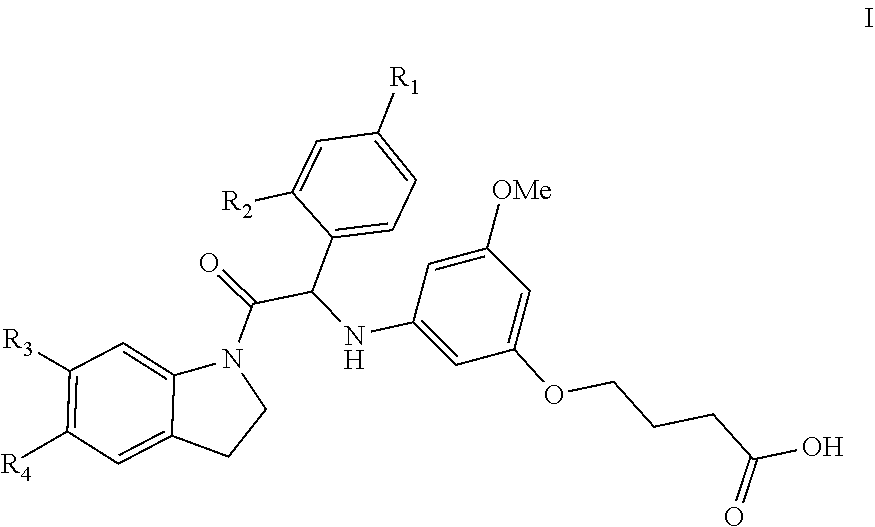Substituted indoline derivatives as dengue viral replication inhibitors
a technology of indoline derivatives and dengue virus, which is applied in the field of substituted indoline derivatives as dengue virus replication inhibitors, can solve the problems of life-threatening infections in man, dhf has become a leading cause of hospitalization and death among children in endemic regions, and the number of dengue cases is increasing, so as to achieve uniform dosage and facilitate administration.
- Summary
- Abstract
- Description
- Claims
- Application Information
AI Technical Summary
Benefits of technology
Problems solved by technology
Method used
Image
Examples
example 1
of 4-(3-((1-(4-fluorophenyl)-2-oxo-2-(6-(trifluoromethyl)-indolin-1-yl)ethyl)amino)-5-methoxyphenoxy)butanoic Acid (Compound 1) and Chiral Separation into Enantiomers 1A and 1B
[0052]
Synthesis of Intermediate 1a
[0053]To a mechanically stirred solution of tert-butyl 4-bromobutanoate [CAS 110661-91-1] (42.3 g, 0.19 mol) in DMF (600 mL) was added in portions a solid mixture of 3-amino-5-methoxyphenol [CAS 162155-27-3] (26.4 g, 0.19 mol) and Cs2CO3 (123.6 g, 0.379 mol). The reaction was stirred at 60° C. for 65 h, and allowed to reach room temperature. The mixture was poured out into H2O (2.5 L). The product was extracted with Et2O (2 times). The combined organic layers were washed with brine, dried over MgSO4 and filtered off. The solvent was evaporated under reduced pressure, and then co-evaporated with toluene. The residue was purified via Normal Phase HPLC (Stationary phase: silica gel 60A 25-40 μm (Merck), Mobile phase: gradient from 20% EtOAc, 80% heptane to 60% EtOAc, 40% heptane)...
example 2
of 4-(3-((1-(4-fluorophenyl)-2-oxo-2-(6-(trifluoromethoxy)-indolin-1-yl)ethyl)amino)-5-methoxyphenoxy)butanoic Acid (Compound 2) and Chiral Separation into Enantiomers 2A and 2B
[0068]
Synthesis of Intermediate 2a
[0069]A mixture of 6-(trifluoromethoxy)indoline [CAS 959235-95-1] (2 g, 9.84 mmol), 2-(4-fluorophenyl)acetic acid [CAS 405-50-5] (1.67 g, 10.8 mmol), HATU (5.6 g, 14.8 mmol) and diisopropylethylamine (4.9 mL, 29.5 mmol) in DMF (40 mL) was stirred at room temperature for 12 h. Water was added and the precipitate was filtered off. The residue was taken up with EtOAc. The organic solution was washed with a 10% aqueous solution of K2CO3, brine, dried over MgSO4, filtered and the solvent was evaporated under reduced pressure. The residue was purified by chromatography on silica gel (15-40 μm, 80 g, heptane / EtOAc gradient 90 / 10 to 60 / 40). The pure fractions were combined and the solvent was concentrated under reduced pressure to give 2-(4-fluorophenyl)-1-(6-(trifluoromethoxy)indoli...
example 3
of 4-(3-((1-(4-chlorophenyl)-2-oxo-2-(6-(trifluoromethyl)-indolin-1-yl)ethyl)amino)-5-methoxyphenoxy)butanoic Acid (Compound 3) and Chiral Separation into Enantiomers 3A and 3B
[0082]
Synthesis of Intermediate 3a
[0083]A mixture of 6-(trifluoromethyl)indoline [CAS 181513-29-1] (3 g, 16.0 mmol), 2-(4-chlorophenyl)acetic acid [CAS 1878-66-6] (3.53 g, 20.8 mmol), HATU (9.1 g, 24.0 mmol) and diisopropylethylamine (7.95 mL, 48.1 mmol) in DMF (75 mL) was stirred at room temperature for 12 h. Water was added and the precipitate was filtered off. The residue was taken up with EtOAc. The organic solution was washed with a 10% aqueous solution of K2CO3, brine, dried over MgSO4, filtered and the solvent was evaporated under reduced pressure. The residue was purified by chromatography on silica gel (15-40 μm, 80 g, heptane / EtOAc gradient 90 / 10 to 60 / 40). The pure fractions were combined and the solvent was concentrated under reduced pressure to give 2-(4-chlorophenyl)-1-(6-(trifluoromethyl)indolin...
PUM
| Property | Measurement | Unit |
|---|---|---|
| temperature | aaaaa | aaaaa |
| wavelength | aaaaa | aaaaa |
| temperature | aaaaa | aaaaa |
Abstract
Description
Claims
Application Information
 Login to View More
Login to View More - R&D
- Intellectual Property
- Life Sciences
- Materials
- Tech Scout
- Unparalleled Data Quality
- Higher Quality Content
- 60% Fewer Hallucinations
Browse by: Latest US Patents, China's latest patents, Technical Efficacy Thesaurus, Application Domain, Technology Topic, Popular Technical Reports.
© 2025 PatSnap. All rights reserved.Legal|Privacy policy|Modern Slavery Act Transparency Statement|Sitemap|About US| Contact US: help@patsnap.com



